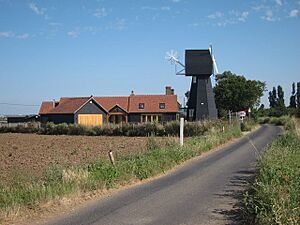Chislet Windmill facts for kids
Quick facts for kids Chislet Windmill |
|
|---|---|
| Origin | |
| Grid reference | TR 224 679 |
| Coordinates | 51°21′59.6″N 1°11′38″E / 51.366556°N 1.19389°E |
| Year built | 1744 |
| Information | |
| Purpose | Corn mill |
| Type | Smock mill |
| Storeys | Three-storey smock |
| Base storeys | Low base of only a few courses |
| Smock sides | Eight-sided |
| No. of sails | Four |
| Type of sails | Spring sails |
| Winding | Fantail |
| Fantail blades | Six blades |
| No. of pairs of millstones | Three pairs |
| Year lost | 2005 |
The Chislet Windmill was a special type of smock mill located in Chislet, Kent, England. It was built a long time ago in 1744. Sadly, it burned down on October 15, 2005. This windmill was once listed as a Grade II building, meaning it was an important historical structure.
Contents
Discovering the Mill's Past
The first time we find a record of a mill in Chislet was in 1666. The Chislet Windmill, the one we are talking about, was built later in 1744. Maps from 1774 and 1819-43 show it was an important landmark.
When the Mill Stopped Working
The mill worked for many years, until 1916. During a big storm, the top part (called the cap) and the large turning blades (sails) blew off. It's thought that the mill's fantail, which helps turn the mill into the wind, was tied up. This meant the mill couldn't face the wind correctly, causing the damage.
A Wartime Secret at the Mill
During the Second World War, a famous inventor named Barnes Wallis lived in the Mill House nearby. He used to watch tests of his amazing invention, the bouncing bomb, from the top of the mill. These tests happened at a place called Reculver.
The Mill's Final Days
After the damage in 1916, the mill's tower was covered with corrugated iron. It still had its main machinery inside. But on October 15, 2005, a fire completely destroyed it. Later, in 2011, a new house was built on the same spot. As part of the new house, a replica (a copy) of the old mill was also built.
How the Windmill Worked
The Chislet Windmill was a three-story "black smock mill." It stood on a low brick base. It had four large "spring sails" that caught the wind. A special part called a "fantail" helped turn the mill so its sails always faced the wind.
Inside, the mill had three pairs of millstones. These large stones were used to grind corn into flour. Many of the mill's parts, like the wallower, upright shaft, and great spur wheel, were made of wood. Some smaller parts, like one of the stone nuts, were made of iron.


